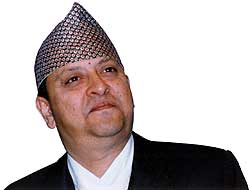 Two major public speeches at the eastern and western edges of the country and countless statements reiterating his commitment to multiparty democracy haven't helped King Gyanendra explain why he had to take political centre stage on the night of October Fourth last year.
Two major public speeches at the eastern and western edges of the country and countless statements reiterating his commitment to multiparty democracy haven't helped King Gyanendra explain why he had to take political centre stage on the night of October Fourth last year. Critics and supporters of the king's assumption of full executive powers after dismissing the "incompetent" but elected Sher Bahadur Deuba government couldn't help but notice the royal proclamation's uncanny resemblance to the language King Mahendra used in Satra Sal in December 1960. The circumstances that led to his enthronement almost two years ago were tragic enough to provide King Gyanendra a tableau of the challenge he confronted in winning the hearts and minds of Nepalis.
In exercising his constitutional prerogative to be consulted, responsibility to warn and right to encourage, the monarch concluded that a little more candour with the news media might help. King Gyanendra lost little time in asserting his belief that the personality of the person wearing the crown goes on to define the role the institution plays.
Long before he invoked Articles 27 and 127 of the constitution, King Gyanendra gave clear hints that his patience was wearing thin. Although he lost his job as a royal nominee to the upper house of parliament for offering gratuitous advice, Dipta Prakash Shaha didn't say much as to what the palace subsequently didn't do.
King Gyanendra may have genuinely intended to administer enough shock therapy on squabbling politicians to make them drive democracy and development together. The stunned politicians took a while to make sense of what had happened. Once they did, they saw footprints back to Panchayat-style authoritarianism. They haven't been seeing anything else. Six months on, the people seem to share that sentiment.
King Gyanendra's address at Dhangadi earlier this month, stressing the need to incorporate market economy, good governance, transparency and corruption-free practices into the national agenda, would have enchanted a Davos audience. Local reaction focused on why he never mentioned the words 'constitutional monarchy'. When more Nepalis believe democracy is at greater risk from the palace than from the Maoists, it's not difficult to gauge the scale of Narayanhity's PR problem.
One soothing aspect of the coarsening of our political discourse is that it has brought some clarity to our thoughts on the monarchy. Girija Prasad Koirala wants use of the Shri Panch title restricted to the three main royals and control of the army handed over to parliament. Madhab Kumar Nepal insists that the palace for its own good must acknowledge that the days of the divide-and-rule doctrine are over.
From the outset, the Maoists have explained their incompatibility with the crown through ideological and battlefield ferocity. Conscious of the need to burnish their democratic credentials, the rebels are ready to go along with what the rest of the people think.
What kind of monarchy does the monarch envisage? Those expected to expand on King Gyanendra's vision of a 21st-century monarchy are shrinking from that task.
The palace has done a poor job of explaining what our leaders have been telling the king all these months. It has been less forthcoming on what the king told the leaders. Bijay Kumar Gachchadar and Jog Mehar Shrestha have managed to convey some of King Gyanendra's concerns. The people don't consider them the most credible messengers. Officially, the only thing we've been hearing is the standard the-crown-created-this-country-so-it-must-save-it line.
From the public comments and private complaints of people presenting themselves as palace confidants, you can cull variations of the following: for an institution where five consecutive monarchs found themselves prisoners to hereditary premiers for over a century, some misgiving is inevitable. For the palace, it doesn't really matter whether the prime minister draws his strength from a democratic mandate or despotic machinations.
When you count the king as a political force, it's unfair to ask him to play a purely ceremonial role. No head of state should be expected to bear silent witness to the depredations of the political class.
A Hindu monarchy of 22 million people and a monarch of 1 billion Hindus are two separate concepts the Nepali crown has to embody. We have no way of knowing how many of these concerns emanate directly from the crown. The palace stopped issuing politically explicit statements during King Mahendra's reign. If they do reflect King Gyanendra's views, then such concerns are central to the national agenda and would have to be conveyed properly. A candid political debate cannot proceed as long as the mainstream parties pretend they have been extending a favour to the palace by not pressing directly for a constituent assembly and continue to get away with it.


